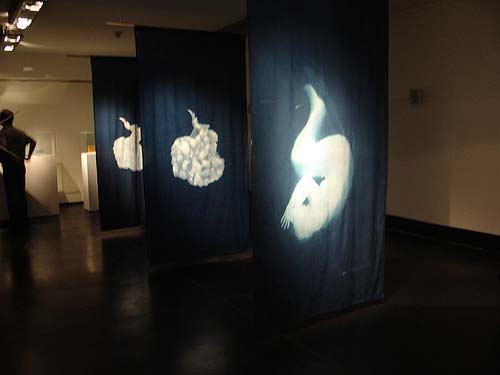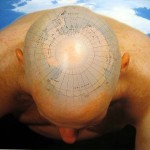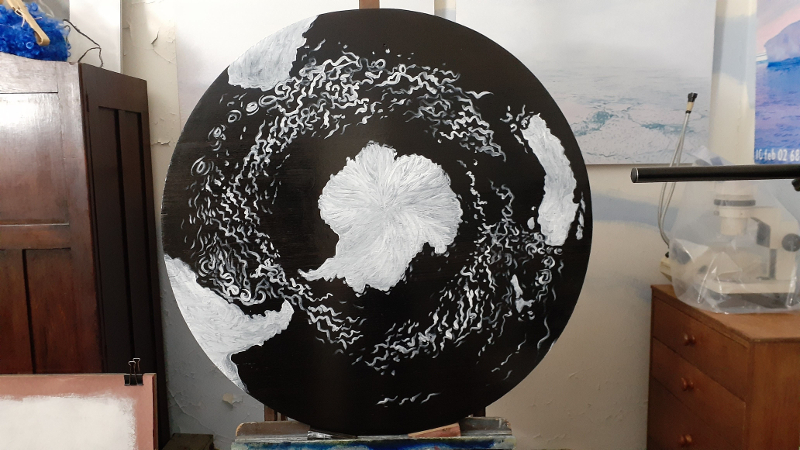‘En perdre le nord (To Loose One’s North Star) is a metaphorical representation of the way in which the traditional image of the “Earth-Mother” is becoming an “Earth-Child” in our collective conscience.’ Artist Philippe Boisonnet, Montreal, 2008

Lorraine Beaulieu, Buenos Aires, 2008

Philippe Boisonnet, Buenos Aires, 2008
As modern humans it seems we have lost our way. We have lost our moral compass. We’ve forgotten how to connect and cooperate with each other and the rest of nature.
Circumpolar Navigation is an experiment in reconnecting hitherto disconnected peoples and knowledge systems, through science, art, software engineering, digital communication and other scholarships and technologies.
This paper and its online interactive map work together to introduce a new model for informing and inspiring policy decisions with scientific accuracy and artful engagement, for enduring understanding and sustainable management of the Southern Ocean ecosystem that governs global health. In this paper we introduce our selves as co-authors of a project that will evolve over the next three years. We invite you to understand (through science) and experience (through art), ways of thinking that together give the holistic view that is necessary to assess and communicate the value of the Southern Ocean to people worldwide. This paper brings together stories from modern science and traditional cultural knowledge systems, acknowledging that wise decisions must be made now, for sustaining humanity. As scientists we acknowledge our biological ancestors as our teachers, as the creatures most evolved in social organisation and cooperation. As artists we recognise beauty, truth and spirit in their stories, that we learn through cultural knowledge, the scientific method, and personal experience. As scholars and technologists we learn from past failures and successes, to build new models for learning, teaching, and acting to sustain life as a whole.
Just as Covid-19 demands that people isolate physically, Circumpolar Navigation invites travel on virtual country. A virtual environment is evolving as different minds come together to share and grow knowledge of connectivity and sustainability.
MEASO-LivingData is developing Circumpolar Navigation as part of a growing movement of people seeking ways of combining knowledge from Indigenous cultural practices and contemporary arts and sciences (Refs Narokobi, Juan…). Our contribution is to focus on the Southern Ocean as connecting and sustaining peoples and places worldwide. Our purpose is to inspire and inform policy makers. Our written publications are being Google-mapped with ‘wormholes’ into virtual country, with place-based stories expressed as scientific data, and art in all its forms. Stories can be fed back into the project, to further evolve human understanding and experience.
Aboriginal Australian Elder Max Dulumunmun Harrison, tells us, “The knowledge is in the land” and that we must listen, learn, embody and pass on that knowledge through our arts and sciences (refs). Indigenous Canadian scholar Shawn Wilson tells us that Indigenous ways of knowing are available to everyone (ref).
Biologist Edward O. Wilson tells us that as humans we are a very new species on this planet, unlike ants who evolved over millions of years to develop altruism and co-operative social behaviours. This suggests that we have a lot to learn from our biological ancestors.
Indigenous cultural practices reflect laws of nature that maintain balance between plants and animals, with agreements (laws) that enable (through ceremony) enduring reciprocity and cooperation between people and nature.
Colonial cultural values, on the other hand, confuse one’s ‘search for self’ with self-seeking. Rather than recognising, respecting and learning from our biological ancestors, Colonial cultures disconnect people from nature and ignore the true natures and responsibilities of people. (refs)
Wilson observes that human behaviours are still driven by primal instincts and that our arts and sciences must work together for us to advance as a species.
“I animate Antarctic sea ice growing and shrinking, and set that cycle to the rhythm of human breath. Artist Philippe Boisonnet writes from his home in Montreal, about his experience of Antarctica: ‘En perdre le nord (To Loose One’s North Star) is a metaphorical representation of the way in which the traditional image of the “Earth-Mother” is becoming an “Earth-Child” in our collective conscience.’ In 2008 I meet Philippe and his wife Lorraine Beaulieu in Buenos Aires, where we contribute to the Festival and Exhibition, Sur Polar: Arte en Antartida, curated by Andrea Juan. Through our art works and presentations we share stories about our times in Antarctica. Lorraine’s images of Antarctica as a woman (herself) inspire the animation, Turning Cycle. Music for the animation comes later, as Antarctic scientist and artist Rupert Summerson plays the shakuhachi (Japanese flute) in an empty hall in Christchurch. We had just heard readings of Antarctic poetry, and Rupert had improvised to a photograph taken by artist Connie Samarus. The photo shows an Antarctic seal emerging through a hole in sea ice, coming up for breath.” Lisa Roberts, Sydney 2020 Ref. Philippe Boissonet, Turning Cycle animation

